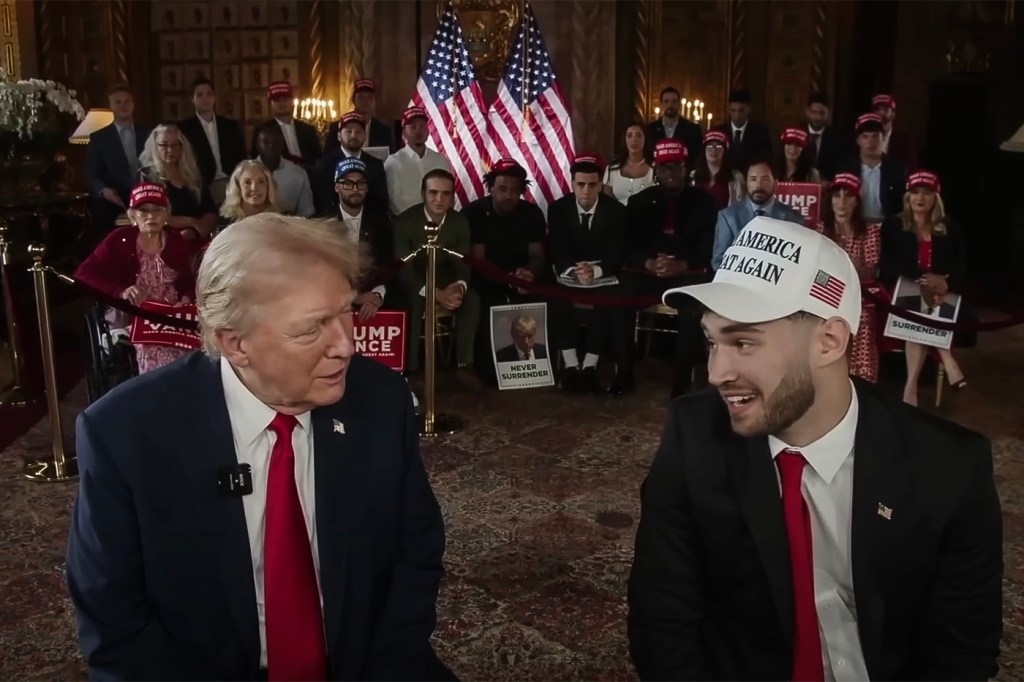Donald Trump is courting influencers like Logan Paul and Adin Ross. What does that say about campaigning in 2024?
In a world where candidates are talking to the press less, they are instead sitting down with influencers to reach, particularly, young voters –– and reinforcing their own political and media bubbles in the process.

Former President Donald Trump recently took his campaign into the world of influencers.
The Republican presidential nominee sat down with Adin Ross, a controversial influencer, at Mar-a-Lago, Trump’s Florida home, for a 90-minute conversation on Kick, a live-streaming platform. Before that, he appeared on a podcast hosted by the similarly controversial YouTuber and professional wrestler Logan Paul.
Trump isn’t alone. Although Vice President Kamala Harris hasn’t yet engaged in any interviews during her nascent run for president, her campaign has been built on with influencer engagement at its core.
This kind of political strategy is far from new. During the 2022 midterm elections, Rep. Alexandria Ocasio-Cortez (D-N.Y.) played the popular video game “Among Us” on streaming platform Twitch to an audience of 400,000 people. What is new, however, is presidential candidates playing ball in this new media environment.
Featured Posts
Katherine Haenschen, an assistant professor of political science and communications studies at Northeastern University, says it represents a cornerstone of campaign communication strategy: “Meet the voters where they’re at.”
In this case, Trump and Harris are waging a war over one of the most vital, yet difficult to reach, voting blocs: young people.
“The voters are now in lots of different places, so it’s up to the campaigns to identify the segment of the electorate that they want to be talking to, and then figuring out a way to get engaging content in front of people on those platforms,” Haenschen says.
“[Young people] are not going to answer the phone. If they live in an apartment, they’re hard to canvas. We might text them, but they get a lot of text messages,” Haenschen adds. “This is another way, and one of the only ways, to reach younger voters. They’re already on these platforms. They’re already in these audience communities.”
The strategy might not be new, but both candidates stepping into influencer culture also comes at a time when they have done few, if any, interviews with the press. The world of influencers presents an opportunity to reach more people in a setting that is still not likely to push the candidate away from their talking points.
“It used to be that the media served as the gatekeeper,” Haenschen says. “Digital media has changed that relationship. I can now just go talk directly with the public.”
By engaging with influencers, a candidate can reach a totally new, and massive, group of people who are willing to listen. It de-emphasizes the candidate as the messenger and leverages the relationship that fans have with their favorite influencer, akin to a person sharing their thoughts with a friend.
“Kamala Harris doesn’t need to be talking to the people who follow politicians because they’re already engaged,” Haenschen says. “What she needs those people to do is to talk to their friends.”
In the case of Trump talking to Ross, it also means the candidate can reach those people without needing to step outside the media bubble that protects them from the more critical lines of questioning.
“If you see [Trump’s] campaign in what I would call a man-o-sphere, especially the right-wing man-o-sphere of the internet, his campaign is looking for people that do agree with him,” Haenschen says.
Whether these kinds of strategies work to engage voter turnout is another question, particularly for Trump. The majority of young people tend to identify as Democrats, so it might seem strange that the Trump campaign is pushing so hard with influencers. But given how tight the presidential race still is, Haenschen says this kind of campaign communication is more about moving the needle in small but meaningful ways.
“We saw the last election came down to a handful of votes in a number of states; 2016 came down to a handful of votes in a number of states,” Haenschen says. “People might be like, ‘Why is Trump bothering to talk to young people?’ If he can increase turnout among Republican-leaning young people, that helps him too. If [young people] don’t go 70 or 75 [percent] for Harris and instead go 65 [percent], that’s a big deal.”











